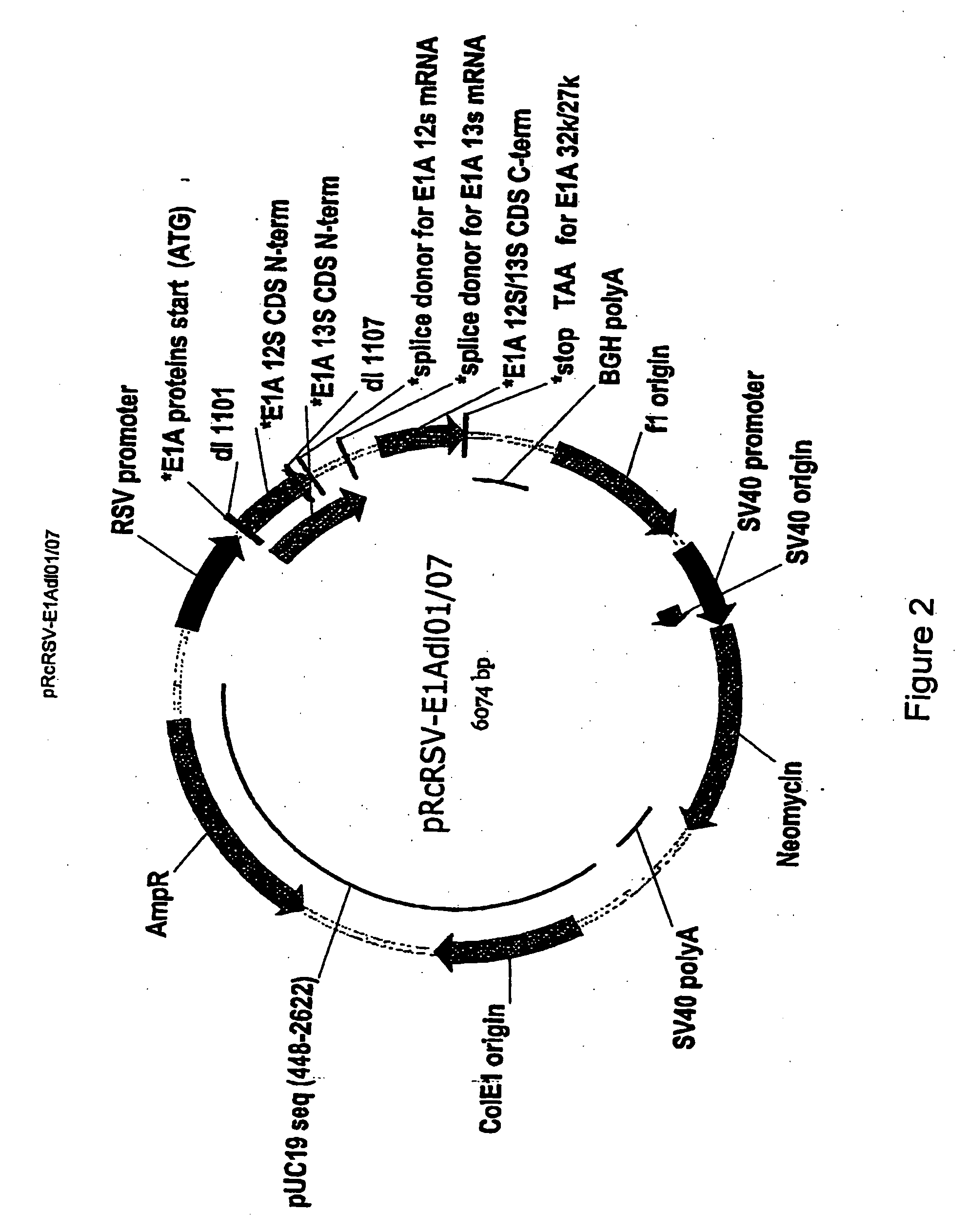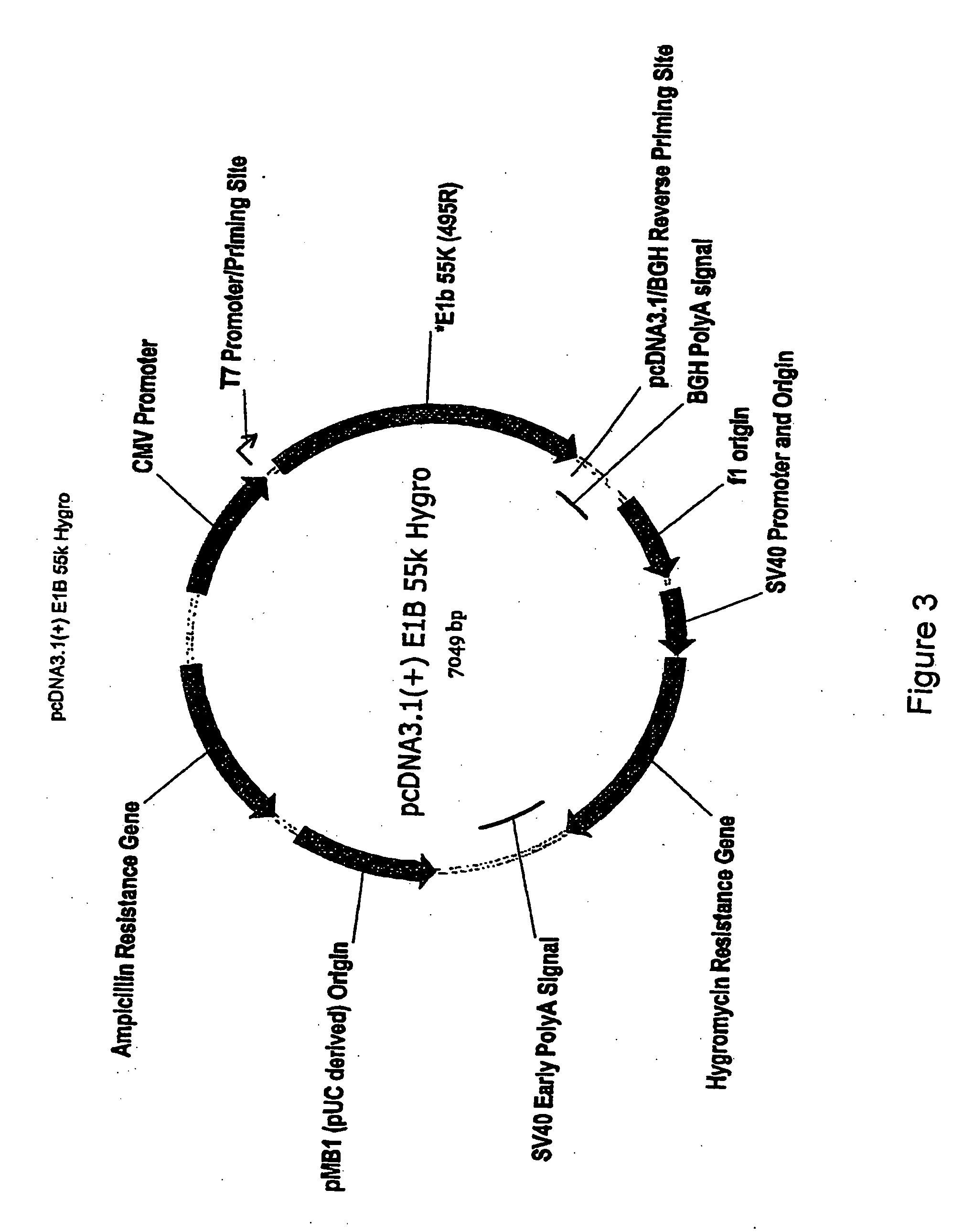Cell lines for production of replication-defective adenovirus
a technology of adenovirus and cell lines, which is applied in the field of cell lines for the production of replication-defective adenovirus, can solve the problems of poor survival rate of adenoviruses, high expression of e1a gene products, and high toxicities of constitutively expressed e1a proteins, so as to facilitate the infection of the producer cell, enhance the production of virus, and increase the concentration of virus
- Summary
- Abstract
- Description
- Claims
- Application Information
AI Technical Summary
Benefits of technology
Problems solved by technology
Method used
Image
Examples
example 1
Generation an E1A and E1b Complementing Cell Line and Use of the Cell Line in the Production of Recombinant Adenovirus
[0218] This example demonstrates the utility of an E1A and E1b complementing cell line for the production of high titers of replication-defective, helper-independent recombinant viruses.
I. Materials & Methods
[0219] Cell Culture
[0220] 293 (ATCC# CRL-1573), A549 (ATCC# CCL-185) and HeLa (ATCC# CCL-2) cells were obtained from the American Type Culture Collection (ATCC, Manassas, Va.). Cell lines were cultured in Dulbecco's Modified Eagle Medium (DMEM) supplemented with 10% (v / v) fetal bovine serum (JRH Biosciences, Lenexa, Kans.), 1% (v / v) antibiotic-antimycotic solution (Cellgro, Kansas, Mo.) and 1 mM sodium pyruvate (BioWhittaker, Inc., Walkersville, Md.).
[0221] Plasmids
[0222] The Ad5 wild-type E1A gene, and E1A sequences containing the E1Adl1101, E1Adl1107 and E1Adl01 / 07 mutations were cloned by standard procedures from pXC1 (McKinnon et al., (1982) Gene 19:33...
example 2
Generation an E1A, E1b and E2b Complementing Cell Line and Use of the Cell Line in the Production of Recombinant Adenovirus
[0269] This example demonstrates the utility of an E1A, E1b and E2b complementing cell line for the production of high titers of replication-defective, helper-independent recombinant viruses.
I. Materials & Methods
[0270] Tissue Culture
[0271] A549, CHO-K1, Saos2, HeLa, and HepG2 cells were all purchased from ATCC. C7 cells (Amalfitano et al. (1996) PNAS 93:3352-3356) were kindly provided by J. Chamberlain, U. of Michigan. Human Tenon's capsule ocular fibroblast cells (designated as HOF cells) were isolated as described in Perkins et al ((2002) Arch. Ophthalmol. 120:941-9). The development of Clone 4 cells are described above in Example 1; the clone is designated clone E1A01 / 07-4i. A549, C7, and HepG2 cells were maintained in Dulbecco's modified Eagle's medium (DME) supplemented with 10% fetal bovine serum (FBS). HeLa cells were maintained in Eagle's minimal e...
PUM
| Property | Measurement | Unit |
|---|---|---|
| temperature | aaaaa | aaaaa |
| volume | aaaaa | aaaaa |
| pressure | aaaaa | aaaaa |
Abstract
Description
Claims
Application Information
 Login to View More
Login to View More - R&D
- Intellectual Property
- Life Sciences
- Materials
- Tech Scout
- Unparalleled Data Quality
- Higher Quality Content
- 60% Fewer Hallucinations
Browse by: Latest US Patents, China's latest patents, Technical Efficacy Thesaurus, Application Domain, Technology Topic, Popular Technical Reports.
© 2025 PatSnap. All rights reserved.Legal|Privacy policy|Modern Slavery Act Transparency Statement|Sitemap|About US| Contact US: help@patsnap.com



